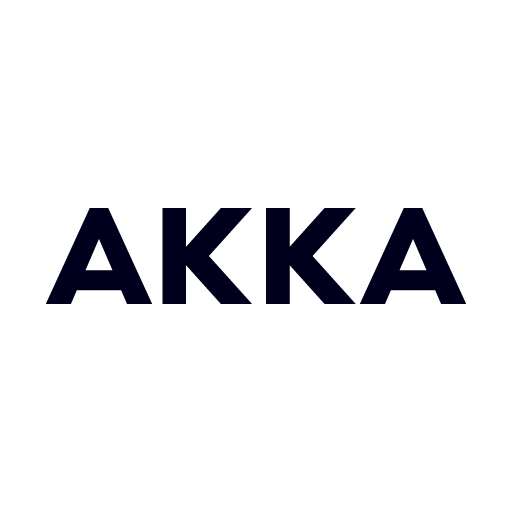The 10 best Temporal alternatives for enterprise teams
Temporal is a powerful open‑source engine for orchestrating complex, stateful workflows, especially long‑running microservices and event‑driven pipelines, making it a viable option across multiple industries.
Built with resilient worker processes and durable execution, it has become a go‑to for teams needing robust orchestration. Yet, as enterprises increasingly pursue simplicity, cost control, AI/ML orchestration, and cloud flexibility, alternatives often surface.
This guide compares leading Temporal alternatives across orchestration capabilities, migration complexity, pricing models, and AI readiness. Whether you're a startup seeking simplicity or an enterprise building intelligent workflows, we'll help you find the platform that fits your needs.
When should you consider a Temporal alternative?
Teams often begin to explore alternatives to Temporal when they encounter key trade-offs in complexity, ecosystem compatibility, deployment preferences, or budget constraints.
Complexity vs. simplicity
One of the most common reasons is the complexity versus simplicity trade-off.
Temporal provides a rich, code-centric workflow orchestration model with features like durable execution, versioning, retries, and signals. While this is highly powerful for complex, long-running processes, it can be excessive for simpler use cases.
In such cases, platforms like Prefect or Cadence offer lighter-weight, easier-to-adopt alternatives with quicker developer onboarding and reduced cognitive load.
Existing ecosystem
Another consideration is the fit within a team’s existing language and ecosystem. Although Temporal supports multiple major languages, Go, Java, Python, and TypeScript, organizations that are deeply embedded in the JVM ecosystem often find Akka or Camunda more suitable due to their JVM lineage.
Similarly, teams operating within the AWS ecosystem tend to prefer AWS Step Functions for its seamless integration with services like Lambda, EventBridge, and DynamoDB.
Deployment preferences
Deployment preferences also play a critical role. Although Temporal supports both self-hosting and consumed through Temporal Cloud, many enterprises require more flexible or constrained deployments.
Alternatives like Camunda, Conductor, and Akka provide more versatile deployment options across on-prem, cloud, or edge environments, giving enterprises greater control over their orchestration infrastructure.
Budget constraints
Budgetary constraints further influence decisions. Managed services such as Step Functions often follow a usage-based pricing model, which can lead to escalating costs as workflows scale.
Open-source platforms might appear cost-effective on the surface, but usually require significant DevOps investment to manage and scale effectively in production environments.
To streamline decision-making, it helps to map organizational needs to available platforms. Enterprises that value JVM-based implementations, auditability, and support for mixed user roles tend to favor Akka or Camunda. Startups or developer-led teams may prioritize simplicity and speed, making Prefect or Cadence more attractive.
For organizations working with AI/ML workflows, particularly those involving agentic AI and prompt chaining, platforms like Airflow or Argo are well-suited for ML pipelines, while Akka, CrewAI, and LangGraph stand out for orchestrating complex, multi-agent systems.
Pain points that often push teams away from Temporal include difficulty debugging deeply nested workflows, the heavyweight nature of its code-only DSL, and a steep maintainability curve for simpler use cases that may not warrant Temporal’s full power.
Top 10 Temporal alternatives to consider
The modern workflow orchestration landscape is rich with tools that cater to specific organizational needs, from enterprise-grade process modeling to cutting-edge AI orchestration. Below is a breakdown of leading alternatives to Temporal, organized by primary use case, along with their unique strengths and suitability.
| Platform | Primary use case | Deployment options | Pricing model | Key strengths |
|---|---|---|---|---|
| Akka | AI-first enterprises, agentic AI systems, distributed stateful systems | Public cloud, private cloud, on-premise, edge | Commercial / Enterprise |
|
| Camunda | BPMN-based orchestration, regulated industries, mixed user roles | Cloud and on-premise | Subscription-based commercial |
|
| AWS Step Functions | AWS ecosystem integration, cloud-native architectures | AWS cloud only | Usage-based (per state transition) |
|
| Netflix Conductor | Microservices orchestration, engineering-heavy organizations | Self-hosted | Open-source (free) |
|
| Prefect | Data workflows, developer experience, analytics | Cloud and on-premise (hybrid) | Free and paid cloud tiers |
|
| Cadence | Code-centric teams, fine-grained control | Self-hosted | Open-source (free) |
|
| Didact | Small teams, startups, simple processes | Self-hosted | Open-source (free) |
|
| Apache Airflow | ETL pipelines, batch data workloads, traditional ML | Self-hosted and managed cloud | Open-source (free), managed versions vary |
|
| Argo Workflows | Containerized workflows, Kubernetes environments | Kubernetes-native | Open-source (free) |
|
| Inngest | Event-driven workflows, AI workflows, background jobs | Cloud and self-hosted | Free tier + usage-based |
|
| DBOS | Database-native workflows, high-performance durable execution | Cloud and self-hosted | Free tier + usage-based |
|
| LangGraph, CrewAI, and other DSL-based AI orchestrators | AI/LLM workflows, agent coordination, AI experimentation | Varies by provider | Usage-based (varies) |
|
1. Akka
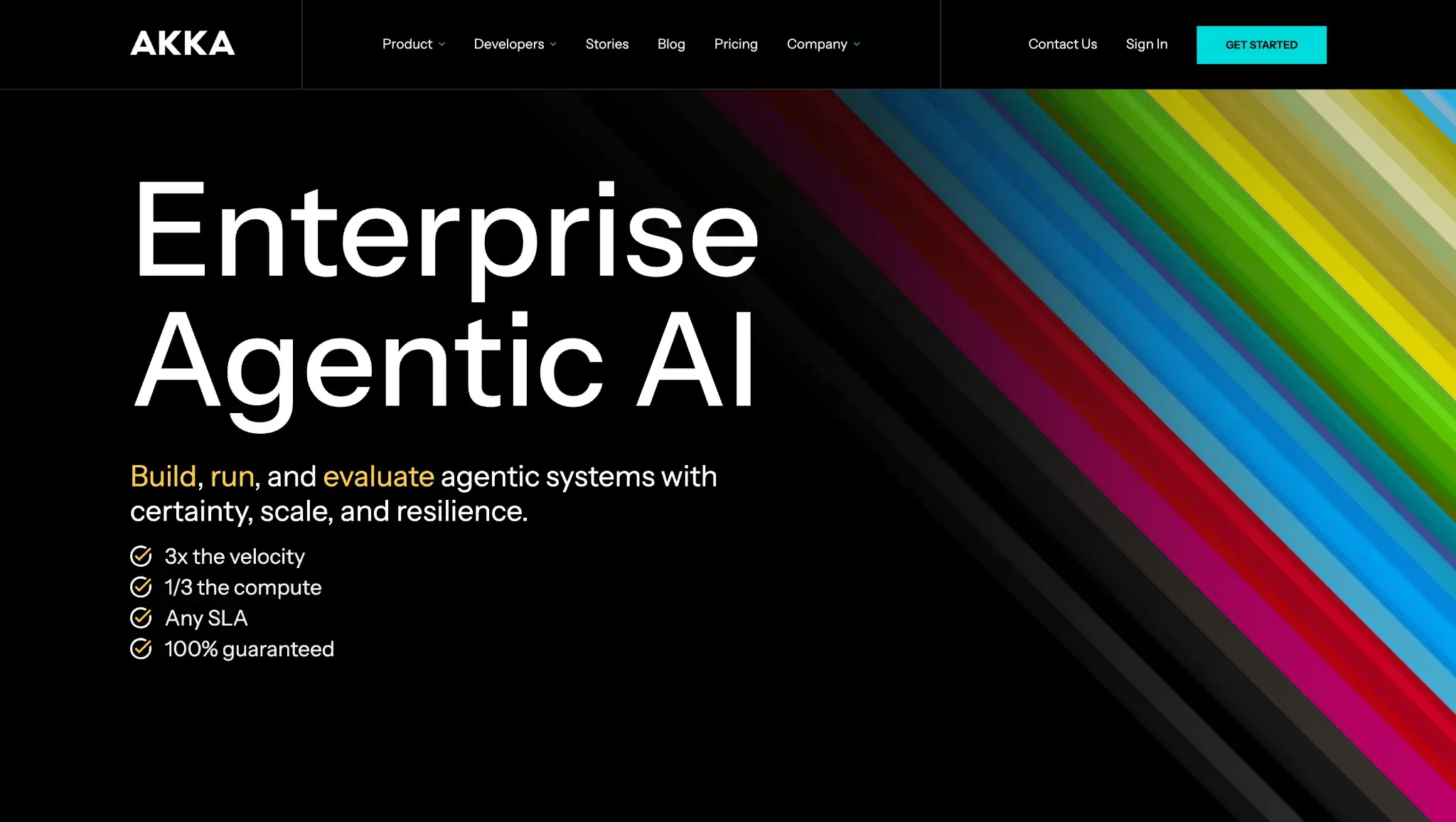
Akka is a powerful, enterprise-grade platform designed for building distributed, stateful, and agentic AI systems. Recent advancements have introduced the Akka Agentic Platform, a fully integrated stack that includes Akka Orchestration, Akka Agents, Akka Memory, and Akka Streaming.
This stack is purpose-built to meet the demands of AI-driven orchestration:
- Akka Orchestration offers durable, checkpointed workflows that can resume from the exact point of failure, with robust support for retries, error handling, and observability.
- Akka Agents empower developers to build goal-directed, stateful agents that come equipped with built-in memory and easy integration with tools and services, removing the complexity of scaling, retry logic, and prompt management.
- Akka Memory provides secure, durable, and replayable state management across sessions or globally, making it ideal for LLM-based pipelines and long-lived agentic workflows.
- Akka Streaming complements the platform by enabling real-time, backpressure-aware data flows, allowing agents to handle live input like telemetry, audio, and video efficiently.
In real-world enterprise environments, Akka is used in highly demanding scenarios, such as multi-region AI systems handling billions of tokens per second with minimal latency. It delivers exceptional performance, reliability, and cost-efficiency.
Deployment is highly flexible, supporting public cloud, private cloud, on-premise, and edge environments. Akka also meets stringent enterprise compliance requirements, including SOC 2, DORA, ISO 27001, and PCI-DSS certifications, and it offers managed operations for advanced needs like multi-region failover and automated certificate rotation.
Pricing: Commercial licensing. Request a demo for detailed pricing.
Best for: Enterprises building sophisticated AI-driven systems with autonomous agents, real-time data processing, and mission-critical reliability requirements.
2. Camunda
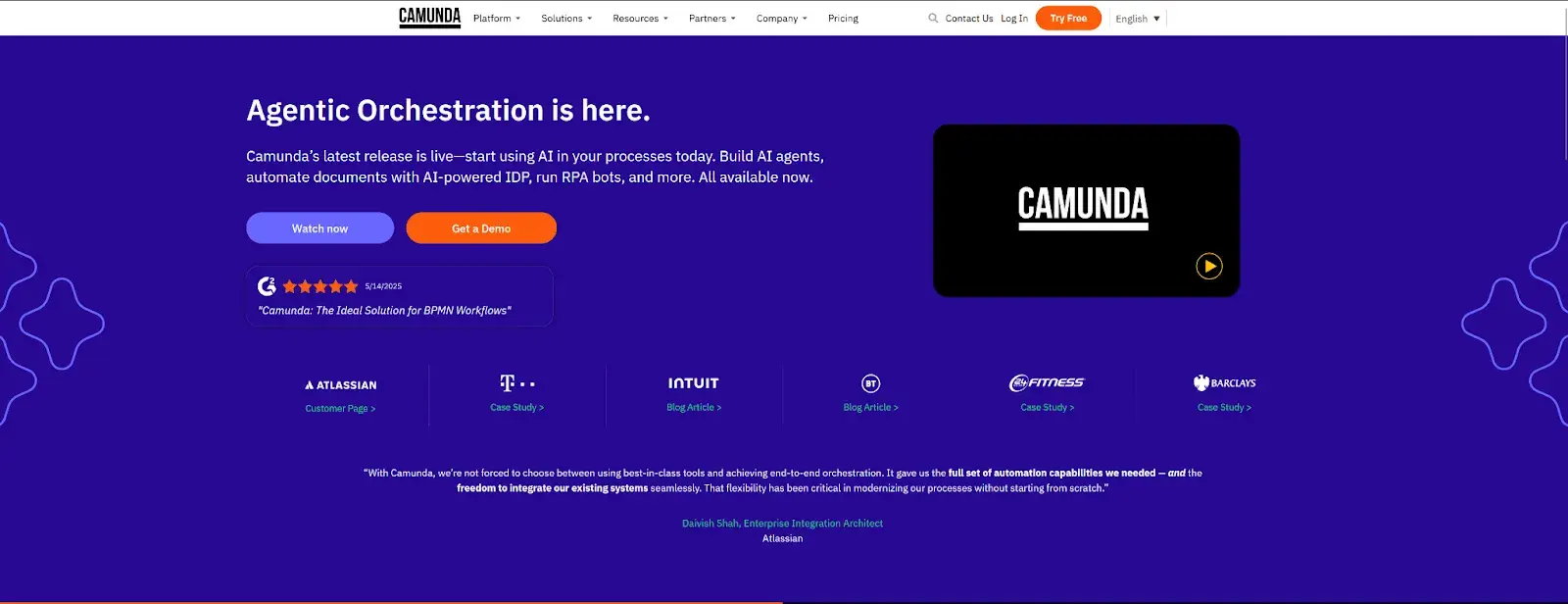
Camunda is a BPMN-based orchestration platform designed for enterprises that need robust business process modeling, auditability, and support for diverse user roles. It supports both cloud and on-premise deployments, making it ideal for organizations with strict regulatory or infrastructure requirements.
Camunda's visual modeling and standards-based approach differentiate it from code-centric tools like Temporal. It's especially well-suited for regulated industries and large teams with mixed technical and business users.
Pricing: Pricing is subscription-based, with a commercial offering layered atop its open-source core.
Best for: Organizations requiring visual process modeling with BPMN standards, regulatory compliance, and collaboration between business and technical teams.
3. AWS Step Functions
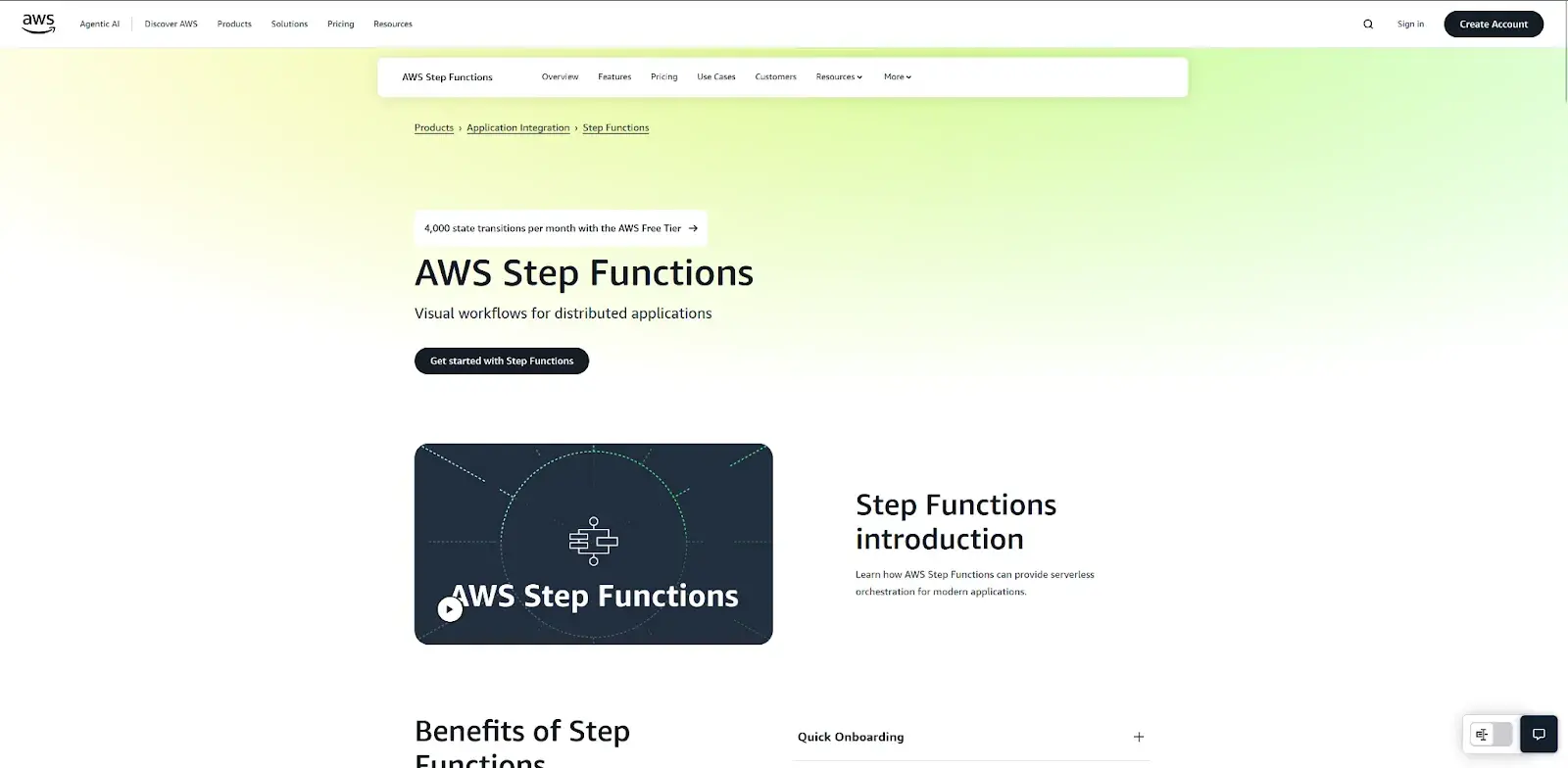
AWS Step Functions provides visual and code-based orchestration natively within the AWS ecosystem. It's a natural fit for teams already invested in AWS services such as Lambda, EventBridge, DynamoDB, and ECS. Its key differentiator is deep integration with AWS services, enabling seamless orchestration across cloud-native architectures.
Pricing: Pricing is usage-based, calculated per state transition, which can be cost-efficient for small workflows but potentially expensive at scale.
Best for: Teams deeply embedded in the AWS ecosystem seeking native cloud orchestration with seamless service integration and minimal operational overhead.
4. Netflix Conductor
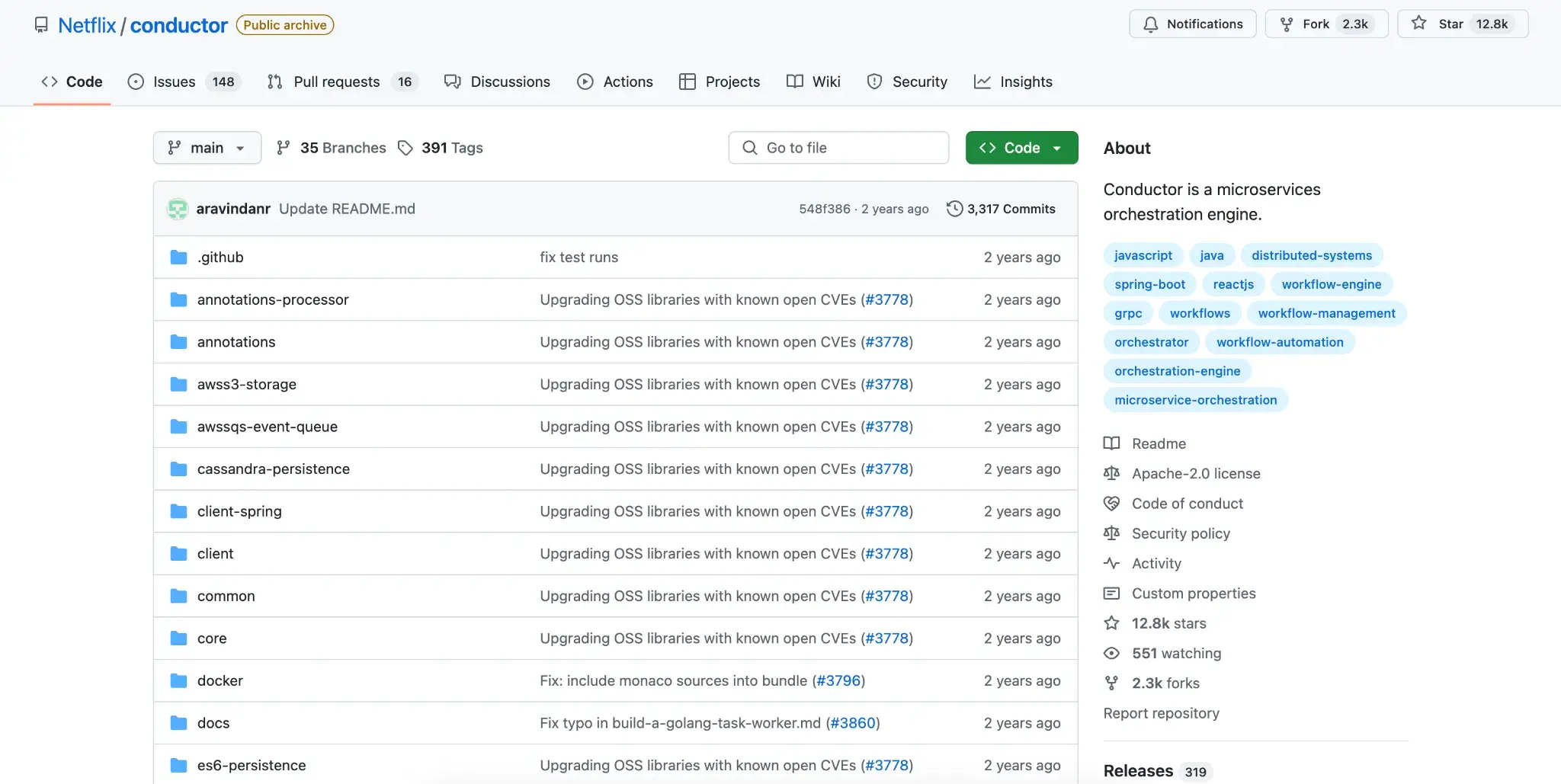
Netflix Conductor is a powerful orchestration engine tailored for microservices-based architectures. It emphasizes event-driven execution, lifecycle callbacks, and scalability across distributed services.
Ideal for engineering-heavy organizations building resilient backend systems, Conductor supports both synchronous and asynchronous tasks.
Pricing: It is open-source and self-hosted, offering flexibility without a commercial license cost.
Best for: Engineering-heavy organizations building resilient microservices architectures that need event-driven orchestration with fine-grained lifecycle control.
5. Prefect
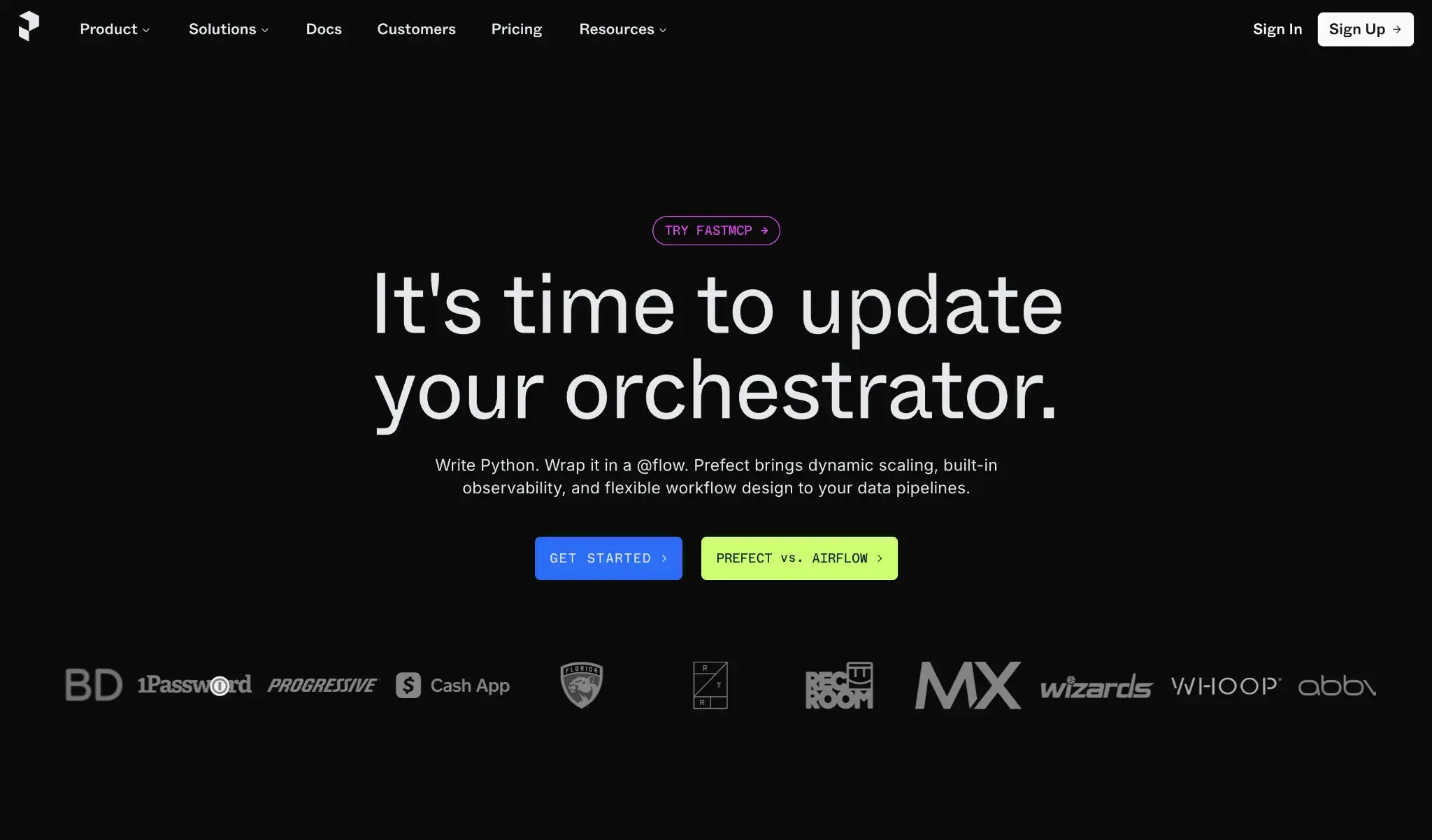
Prefect is a Python-native orchestration framework designed for data workflows and developer experience. It enables fast prototyping and execution of DAGs (Directed Acyclic Graphs) and supports both cloud and on-premise deployments.
Its hybrid execution model allows users to manage infrastructure while offloading orchestration logic to Prefect Cloud if desired. Prefect is ideal for data teams, analytics workflows, and engineers who value code-first simplicity.
Pricing: Prefect offers both free and paid cloud tiers.
Best for: Data teams and Python developers who want rapid workflow development with a modern developer experience and flexible cloud/hybrid deployment options.
6. Cadence
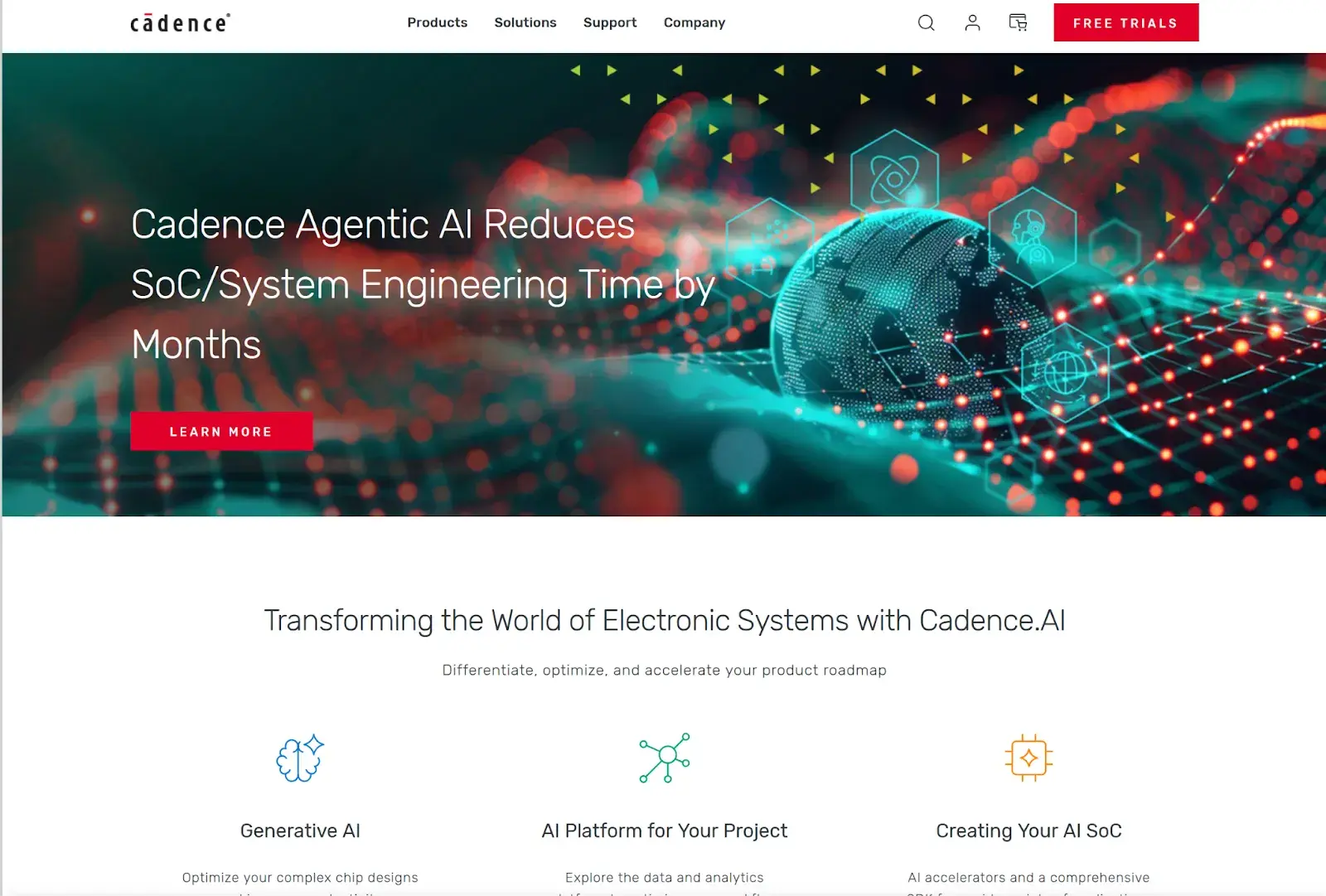
Cadence, originally developed by Uber, is Temporal's open-source predecessor. It provides similar capabilities for orchestrating stateful, fault-tolerant workflows.
Best for code-centric teams seeking fine-grained control without Temporal's managed services or cloud lock-in, Cadence supports multiple languages and is fully open-source. It’s a compelling choice for those wanting Temporal-like functionality without adopting Temporal Cloud.
Pricing: Free and open-source.
Best for: Teams wanting Temporal-like capabilities with complete control over deployment, no vendor lock-in, and a lighter operational footprint.
7. Didact
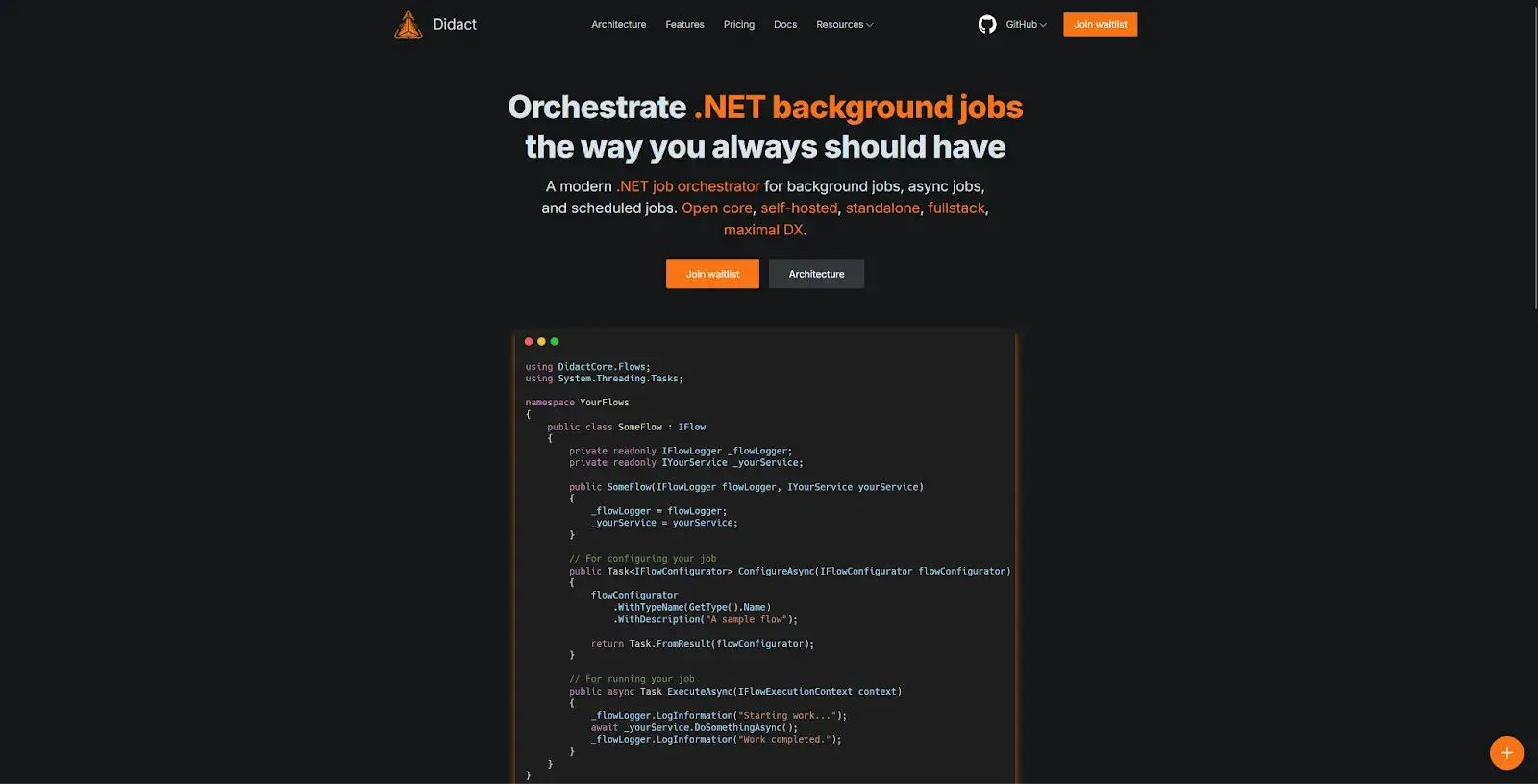
Didact is a newer entry in the orchestration space for .NET, focused on lightweight, developer-friendly workflows. It targets small teams or startups that want to automate simple processes without heavy infrastructure or complex DSLs. Its simplicity and emerging tooling make it a low-friction alternative to Temporal for basic orchestration needs.
Pricing: Open-source and free to use.
Best for: Small teams and startups needing simple workflow automation without complex infrastructure requirements or steep learning curves.
8. Apache Airflow
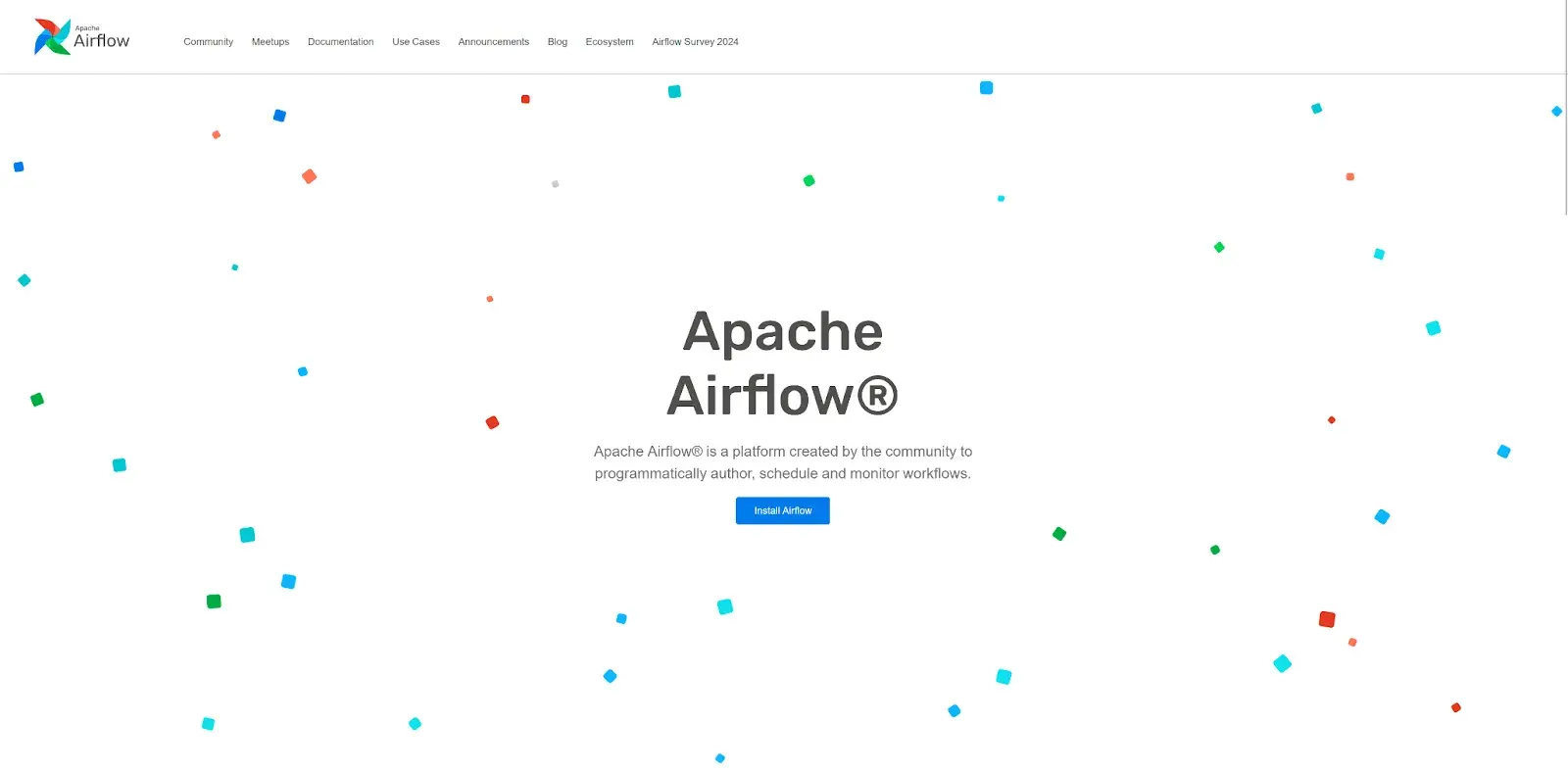
Apache Airflow is the industry standard for scheduling and orchestrating ETL pipelines. It uses a Python-based DAG model, offering rich integrations with data tools and services. Airflow is particularly well-suited for batch data workloads, analytics pipelines, and traditional ML processes.
It’s supported by a wide open-source community and offers both self-hosted and managed cloud versions via vendors like Astronomer and Google Cloud Composer.
Pricing: Free and open-source under the Apache Software Foundation.
Best for: Data engineering teams managing ETL pipelines, batch processing, and traditional ML workflows with extensive ecosystem integrations.
9. Argo Workflows
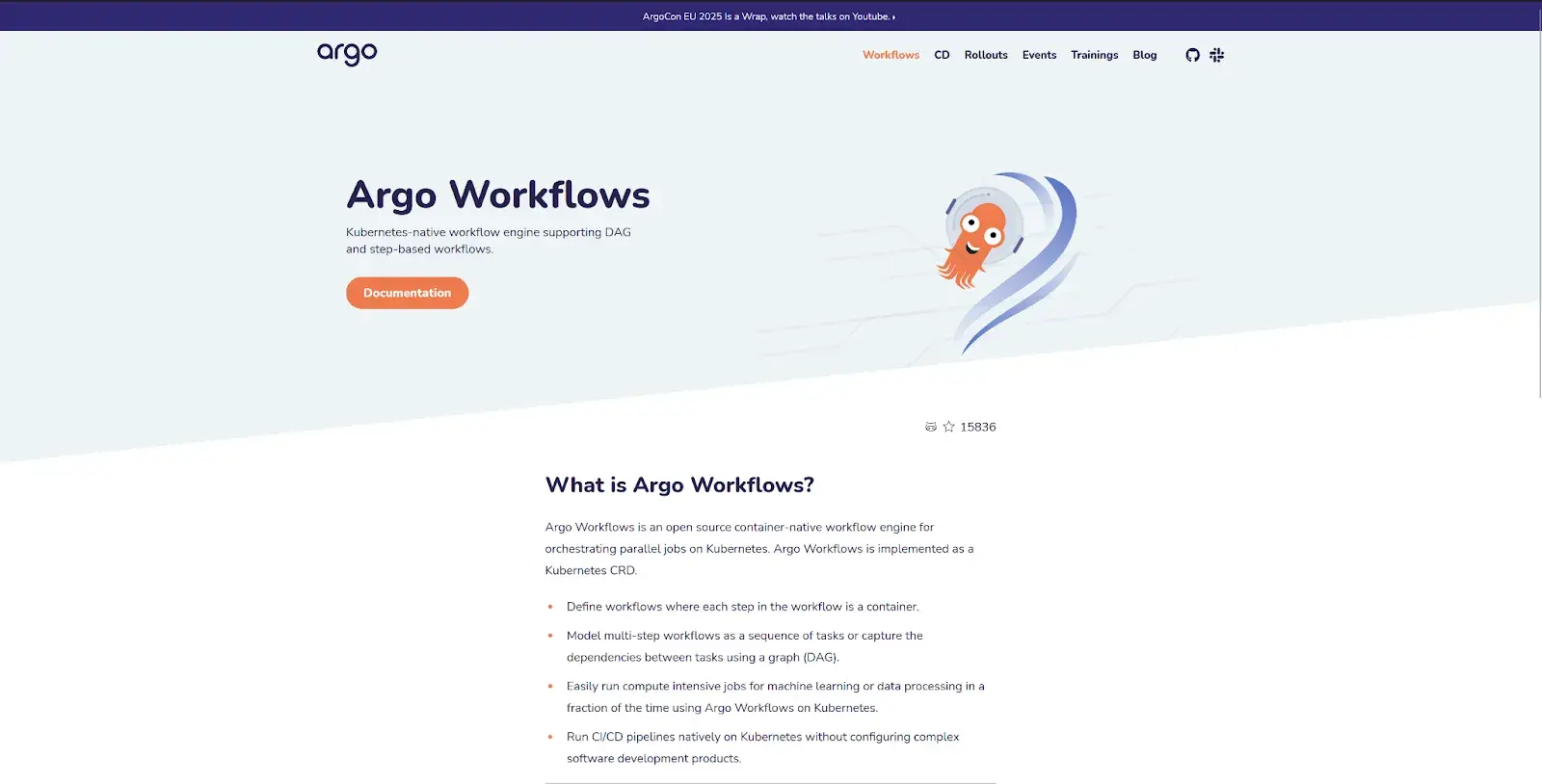
Argo Workflows is purpose-built for orchestrating containerized workflows in Kubernetes environments. It executes DAGs natively on K8s, making it a strong fit for teams already managing ML, CI/CD, or data processing workloads in containers.
Argo's differentiator is its seamless Kubernetes integration, with native scaling and declarative templates. It is open-source and ideal for teams with strong DevOps and infrastructure-as-code practices.
Pricing: Free and open-source CNCF project.
Best for: DevOps teams running containerized workloads in Kubernetes environments who need native K8s integration and declarative workflow management.
10. Inngest
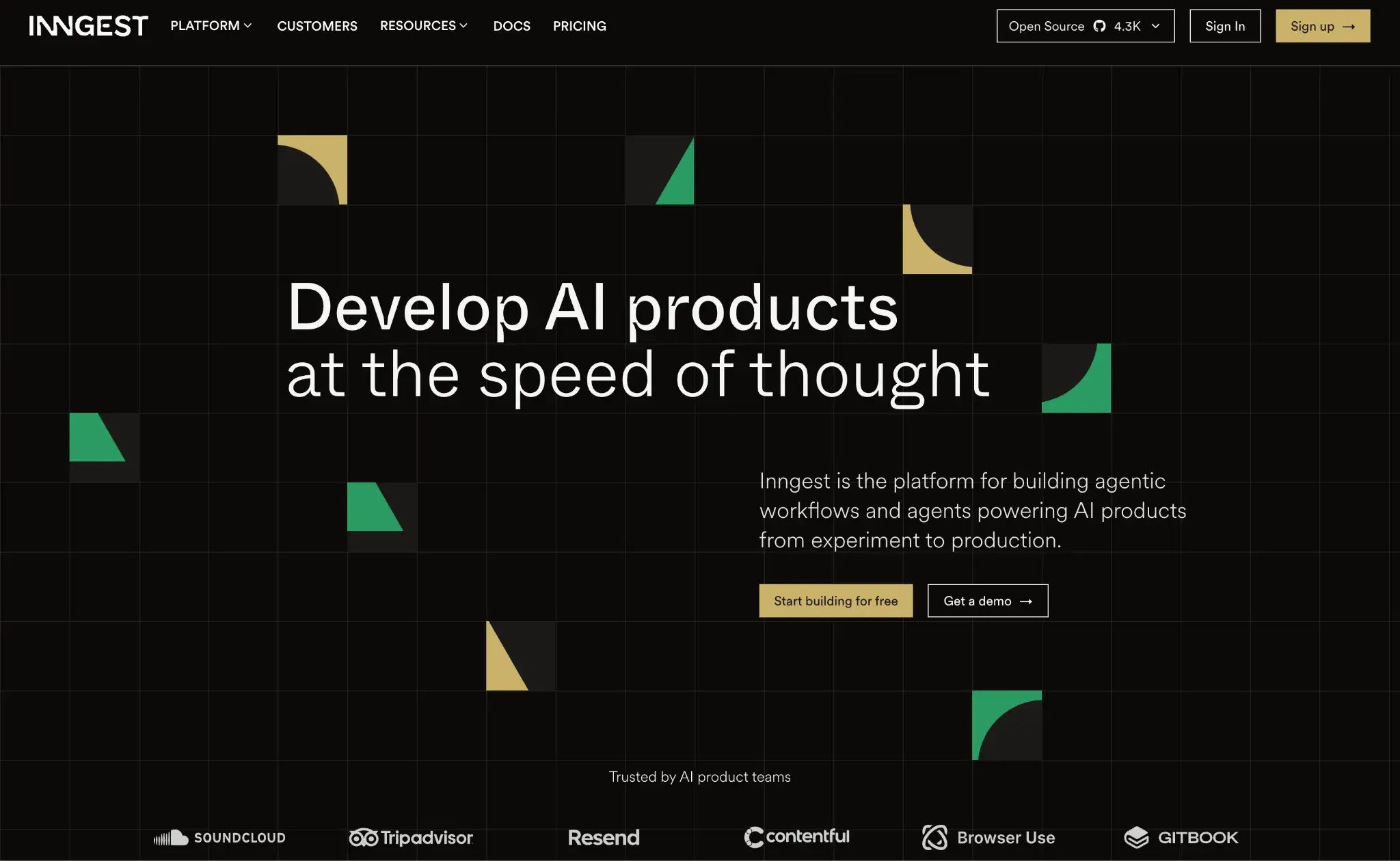
Inngest is an event-driven durable workflow platform that replaces traditional queues, state management, and scheduling with durable functions that automatically handle retries, concurrency, and orchestration without infrastructure overhead.
The platform features built-in flow control capabilities, including concurrency management, throttling, and rate limiting, making it particularly well-suited for AI workflows and multi-tenant applications.
Pricing: Free open-source library (DBOS Transact), usage-based pricing for DBOS Cloud hosting.
Best for: Development teams building event-driven applications, AI workflows, and background job processing who want durable execution capabilities without managing infrastructure like queues or schedulers.
11. DBOS
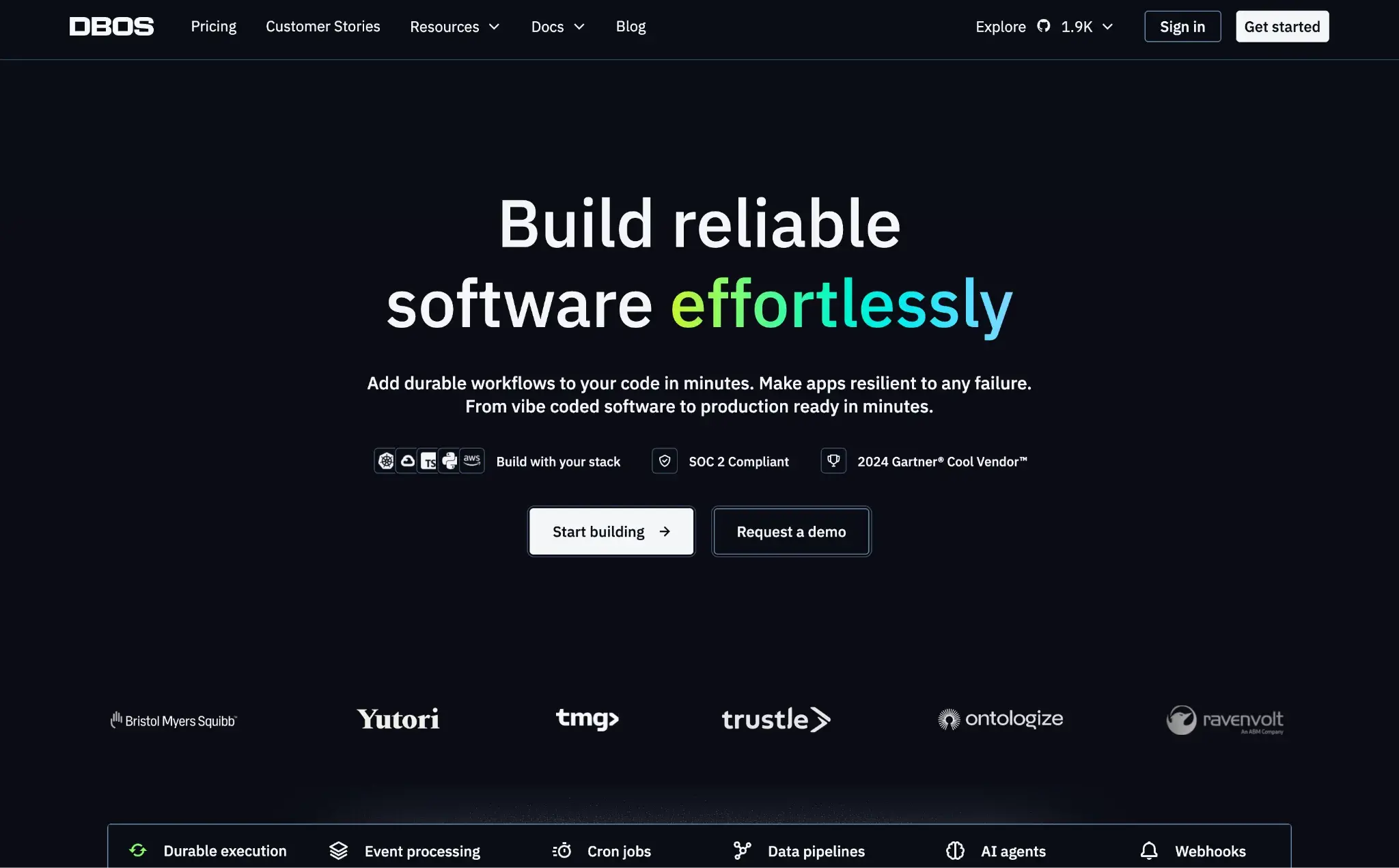
DBOS is a database-oriented platform that implements durable execution by storing all application state and workflow progress directly in a database. Built on the concept of a database-oriented operating system, DBOS eliminates traditional orchestration layers by making the database the core component for state management and workflow coordination.
The platform includes unique features like time-travel debugging, which allows developers to debug applications against the database state as it existed during the original workflow execution. Additional capabilities in
Pricing: Free tier offers 1 million service calls per month with 3-day data retention, using managed PostgreSQL.
Best for: Teams requiring high-performance durable execution with database-native state management, particularly those building data-intensive applications that need minimal latency and maximum reliability.
12. LangGraph, CrewAI, and other DSL-based AI orchestrators
Emerging tools like LangGraph and CrewAI are specifically designed to support large language model (LLM) workflows and agent coordination. These platforms introduce orchestration DSLs tailored to multi-agent systems, prompt chaining, and contextual memory management.
They are most useful for AI teams experimenting with autonomous agents, tool use, and reasoning chains. Their pricing models vary, often depending on usage and hosting provider.
Best for: AI research teams and developers experimenting with large language models, autonomous agents, and prompt-based workflows in rapidly evolving AI environments.
Making the right choice: Implementation and migration
Choosing the right Temporal alternative requires a structured evaluation process that considers both technical and strategic priorities. A helpful checklist for evaluating orchestration platforms should begin with identifying your modeling needs, whether your team prefers visual tools like BPMN or code-first approaches.
Next, assess language and platform compatibility to ensure the tool aligns with your existing tech stack. Deployment flexibility is another major factor: does the solution support multi-cloud or on-premise environments, or is it tied to a specific vendor?
In today’s rapidly evolving landscape, AI and agentic orchestration support are becoming increasingly important. Teams working on autonomous agents, LLM workflows, or AI-powered services should prioritize platforms that offer durable state management, real-time streaming, and LLM integration capabilities.
Additionally, examine the cost structure, including whether the pricing model is usage-based, infrastructure-intensive, or license-driven. Finally, don’t overlook operational concerns; evaluate how well the platform supports debugging, monitoring, and observability out of the box.
When it comes to migration effort, the complexity can vary widely. Moving from Temporal to lighter-weight tools like Prefect or Airflow for Python-based DAGs is generally low-effort and quick to implement.
Moderate migrations include transitions such as Temporal to Cadence, which share architectural roots, or Step Functions to Camunda, where conceptual models are different. Still, the visual orchestration layer offers a smoother transition.
The highest migration complexity arises when shifting to actor-based systems like Akka, particularly for teams moving from traditional orchestration into agentic AI systems. These migrations require architectural rethinking but can offer substantial long-term benefits in terms of flexibility, durability, and AI orchestration.
For organizations venturing into agentic AI, platforms like Akka are particularly compelling due to their support for persistent memory, event streaming, multi-region clustering, and robust orchestration of autonomous agents.
As noted in resources from Akka’s documentation and real-world case studies, Akka’s actor-based runtime enables long-lived workflows that maintain state across failures and reboots, an essential feature for intelligent agents operating in dynamic environments.
To ease the transition, organizations should aim for quick wins by launching a pilot pipeline on the new platform and tracking time-to-value. This approach allows teams to evaluate fit before fully committing.
Building a long-term migration roadmap and aligning stakeholders on tooling decisions helps ensure your infrastructure is capable of supporting future AI-native orchestration requirements. By thinking strategically and acting iteratively, organizations can modernize their orchestration stack while positioning themselves for success in the AI-first era.
Final thoughts
The orchestration landscape is becoming richer and more specialized. Our framework, which matches needs to systems, can guide teams from code‑centric debuts to enterprise-scale orchestrators and agentic AI platforms.
Akka stands out for AI-first enterprises, offering a robust actor-based runtime with clustering, streaming, memory, and orchestration suited for long-running, multi-agent workflows, perfect for enterprise-grade agentic systems.
Ground your choice on your architecture, domain, and future AI needs. As AI-driven orchestration becomes fundamental, Akka gives organizations a durable, resilient, and flexible platform to build truly agentic systems at scale, ushering in the next generation of enterprise workflows.
In the coming years, the convergence of real-time data, autonomous decision-making, and AI-native infrastructure will redefine how organizations approach process orchestration.
Platforms like Akka are not just filling current gaps; they are laying the groundwork for intelligent, autonomous, and scalable systems that evolve with business needs. For teams looking to stay ahead in the era of agentic AI, adopting Akka is a strategic investment in the future of enterprise software. Contact Akka today to find out more and get started!
Posts by this author


